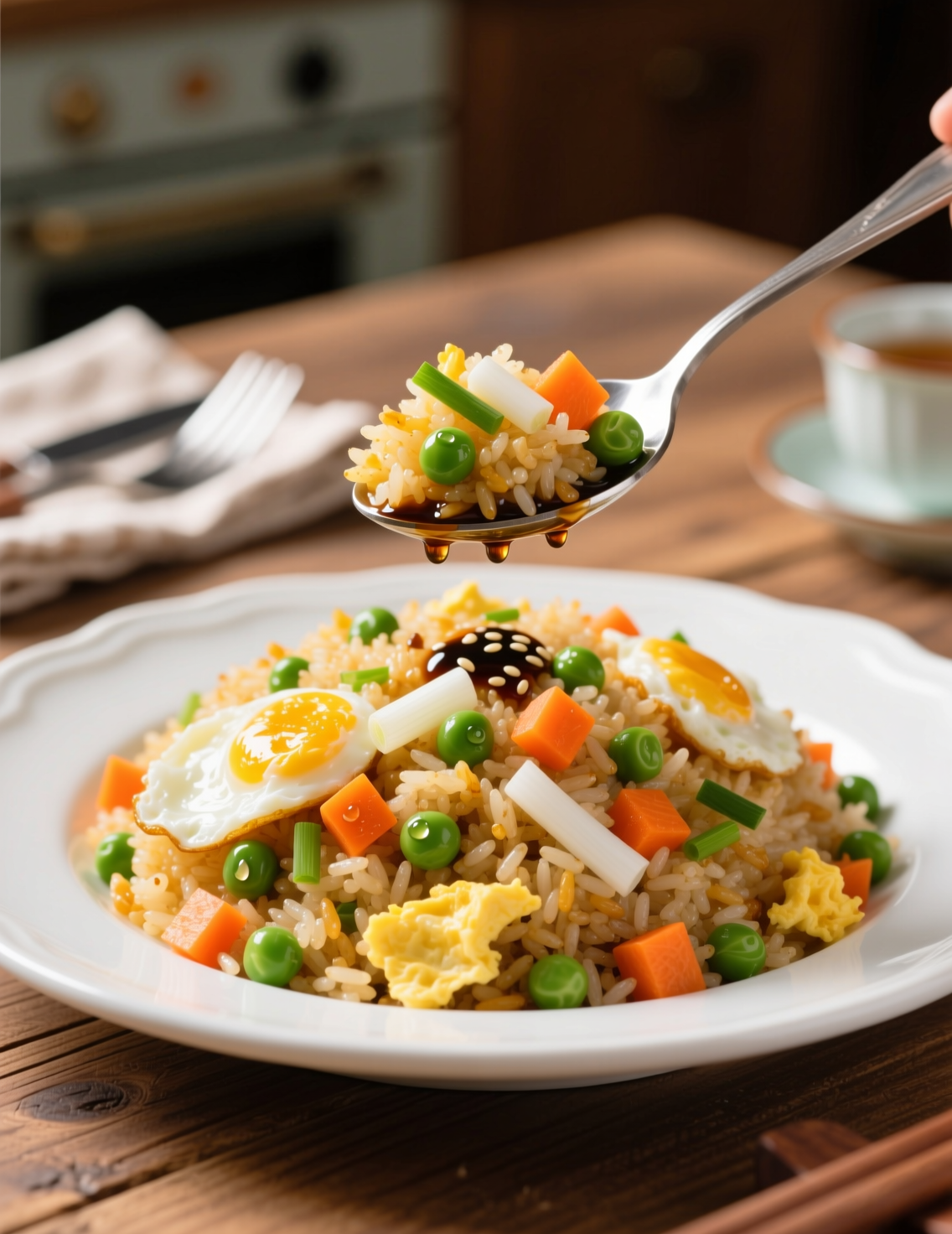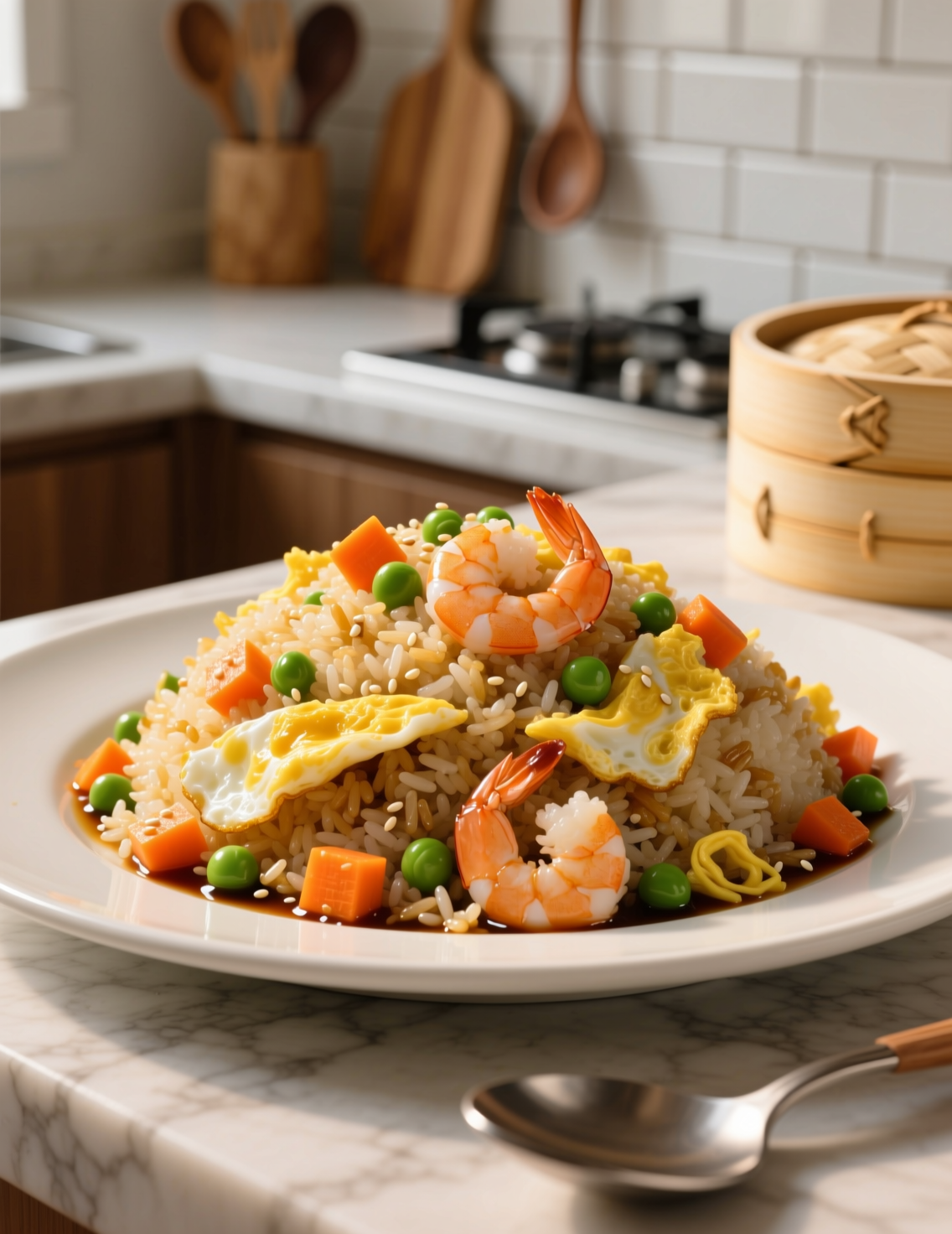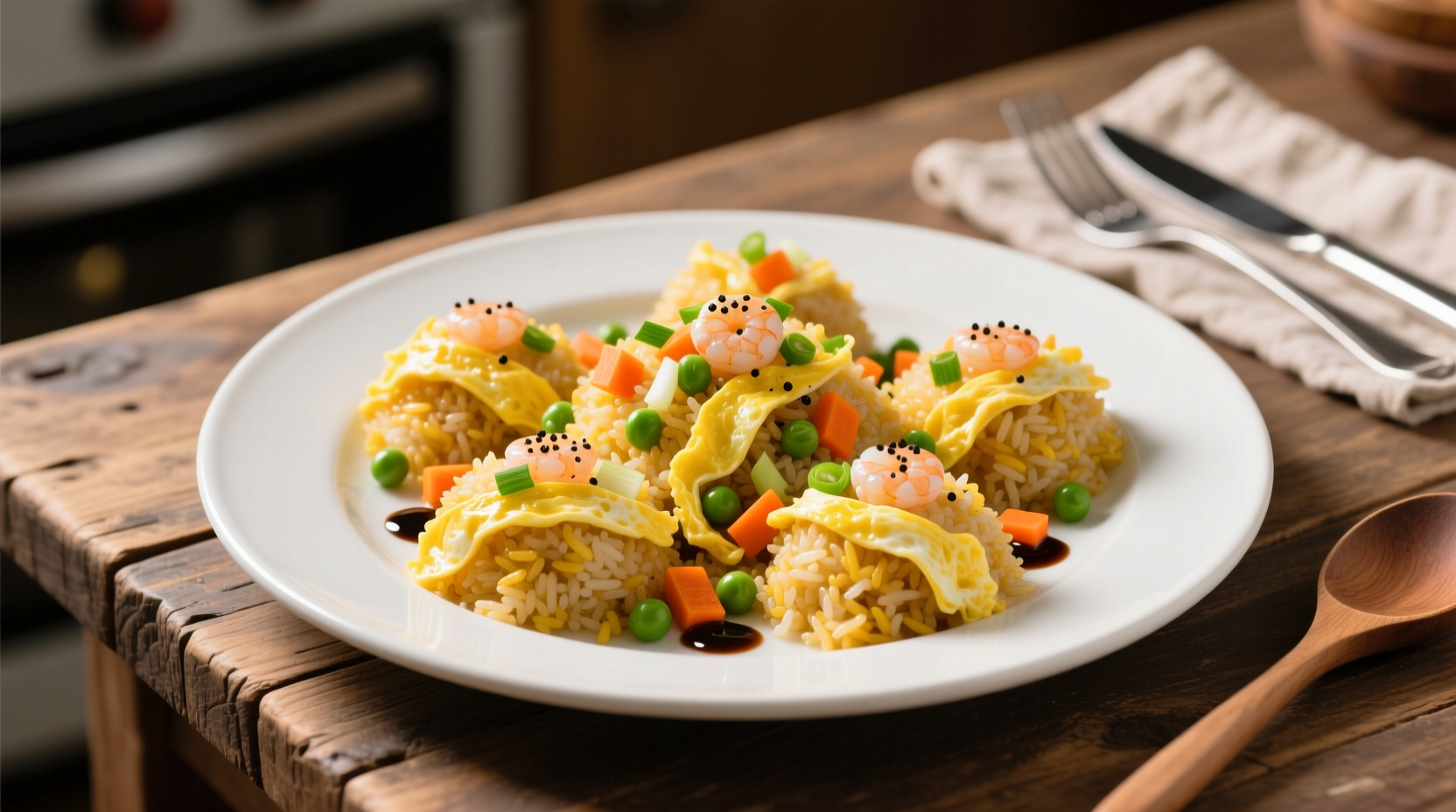Egg fried rice. A dish that seems so simple, yet every professional chef knows it hides a thousand tiny decisions. Cooked rice, eggs, and aromatics tossed in hot oil—sounds basic, but the mastery lies in the details. This article takes you beyond the quick home recipe, into the nuances that make egg fried rice worth studying in culinary schools and served with pride in professional kitchens. Here, we’ll break down an authoritative recipe for 6 servings while weaving in techniques, research, and expert-level insights that set it apart.
Why Egg Fried Rice Deserves Respect
Some cooks dismiss fried rice as “just leftovers.” That’s a mistake. In China, it has roots dating back more than 1,500 years, often credited to the Sui dynasty. Today, it’s a global dish, appearing everywhere from Michelin-starred restaurants to humble takeout counters. What makes it timeless? Its adaptability. At its core, egg fried rice is both economical and endlessly customizable. For professionals, it’s also the perfect test of wok control, timing, and ingredient knowledge.
The secret isn’t just what you put in, but what you leave out. Too much soy sauce, and the rice becomes muddy. Too little heat, and the grains clump. Eggs scrambled too long turn rubbery. A deceptively fragile balance, if you ask any chef worth his salt.
Ingredients for 6 Servings
Let’s start with the essentials. Precise measurements matter when you’re cooking for multiple diners, whether in a restaurant setting or at home hosting.
- 5 cups cooked jasmine rice (preferably day-old, chilled)
- 6 large eggs
- 4 tbsp neutral oil (peanut or canola work best)
- 1 ½ cups diced vegetables (peas, carrots, bell pepper mix)
- ½ cup scallions, sliced thin
- 3 tbsp light soy sauce
- 1 tbsp oyster sauce (optional but adds umami depth)
- 1 tsp sesame oil
- 1 tsp white pepper
- Salt to taste
Notice what’s not on the list: garlic. Many versions add it, but traditional Cantonese egg fried rice avoids strong aromatics. Garlic can overpower the subtlety of egg and rice harmony. Still, in modern kitchens, chefs adapt freely, so if you want garlic, just slice it paper-thin and fry it briefly before adding rice.

The Importance of Rice Texture
Professional chefs will tell you—the rice makes or breaks this dish. Freshly steamed rice is almost impossible to fry well. It clumps, steams instead of frying, and soaks up oil unevenly. That’s why day-old rice is gospel. Refrigeration dries the grains, firms the starch, and prevents stickiness when tossed in a wok.
Some chefs even spread freshly cooked rice onto sheet pans, chilling them rapidly to simulate overnight rice. In high-volume kitchens, this trick keeps service smooth without sacrificing texture. Research by the Journal of Food Science shows that cooling cooked rice alters its amylose and amylopectin balance, essentially making it more “fryable.” That’s science backing tradition.
Step-by-Step Cooking Method
Now to the heart of it—execution.
- Prep your mise en place. Crack the eggs into a bowl and beat lightly. Dice vegetables evenly for uniform cooking. Have rice fluffed and ready, breaking apart large clumps.
- Heat the wok or skillet. A carbon steel wok over high flame is ideal. It reaches searing heat quickly and develops wok hei—that smoky aroma chefs chase. If unavailable, a heavy nonstick pan works, but you’ll lose some complexity.
- Scramble the eggs. Add 1 tablespoon oil, pour eggs in, and stir quickly. Remove them while still slightly soft; they’ll finish later. Overcooked eggs ruin texture.
- Cook vegetables. Add another tablespoon of oil. Toss vegetables briefly until just tender, not soggy. High heat is key—think 90 seconds, not five minutes.
- Add rice. Pour remaining oil, then rice. Spread it out, press down lightly, and let it sear before stirring. This prevents steaming. Stir with broad, lifting motions, separating grains.
- Season. Add soy sauce, oyster sauce, sesame oil, white pepper, and salt. Mix quickly, ensuring sauces coat grains rather than pooling.
- Finish. Return eggs and scallions. Toss to distribute evenly. Taste, adjust seasoning, and serve hot.
Professionals often taste multiple times during the process. Tiny corrections—more soy, a pinch of salt, maybe a splash of stock—create balance.
Wok Hei: The Invisible Ingredient
Every serious discussion of fried rice circles back to wok hei, literally “breath of the wok.” It’s a smoky, slightly charred essence created when food meets extremely hot metal, oil vaporizes, and Maillard reactions accelerate. Achieving it requires three things:
- A well-seasoned carbon steel wok.
- A heat source exceeding 700°F.
- Speed and confidence when tossing.
Home stoves rarely hit this level, but professionals know tricks. One is cooking smaller batches. Another is preheating the wok until it just begins to smoke, then adding oil. Even in modest kitchens, these tweaks edge you closer to authentic wok hei.
Variations Across Cultures
While this recipe focuses on a Cantonese-inspired version, fried rice has countless variations. Indonesian nasi goreng relies heavily on kecap manis, a sweet soy sauce. Thai fried rice uses fish sauce and lime for a sharper bite. Japanese chāhan leans lighter, often with pork belly.
Even within China, regional differences shine. Yangzhou fried rice includes shrimp and char siu pork. Hokkien versions are darker, with heavier soy. Egg fried rice stands out because of its minimalism. It’s stripped down, leaving no place to hide mistakes. That’s why chefs respect it—it’s rice and eggs, nothing to distract you from execution.
Nutritional Insights
For six servings, each plate provides roughly:
- Calories: 380–420
- Protein: 11–14 g
- Fat: 14–16 g
- Carbohydrates: 52–55 g
- Sodium: 680–750 mg
The balance makes it a moderate main or a substantial side. Adding protein like shrimp or chicken boosts satiety, while swapping white rice for brown raises fiber. Some chefs now experiment with quinoa or cauliflower rice for low-carb versions, though purists roll their eyes. Still, as diets shift, adaptation keeps dishes alive.

Common Mistakes Professionals Avoid
- Using fresh rice. Already explained—sticky disaster.
- Overloading the wok. Crowding drops temperature, leading to steaming instead of frying. Better to cook in two smaller batches.
- Dark soy overload. It looks dramatic but muddies flavor. Light soy sauce seasons without overpowering.
- Under-seasoning eggs. Eggs benefit from a pinch of salt before scrambling. Neglecting this makes them bland.
Small errors multiply fast. Professionals develop muscle memory—heat control, timing, seasoning—so each step happens instinctively.
Emerging Trends with Egg Fried Rice
Modern chefs are pushing boundaries. Some use duck fat instead of oil for richness. Others fold in truffle shavings or caviar, creating luxurious versions that land on fine dining menus. At the opposite end, street vendors experiment with chili crisp, kimchi, or even curry powder for bold fusion twists.
Data from food industry reports show a 23% rise in fried rice dishes on global menus between 2018 and 2023. It’s not just nostalgia; it’s practicality. Cheap, quick, satisfying. For professionals, it’s also a canvas for creativity.
Expert-Level Tips for Perfect Results
- Keep rice spread thin while frying; don’t let it pile up.
- Stir with wrist flicks, not arm swings, for better grain separation.
- Use white pepper instead of black for authenticity. Black can overwhelm delicate flavors.
- Don’t skip scallions. They add freshness, cutting through richness.
- If cooking in volume, warm plates before serving. Cold plates dull texture fast.
Professional kitchens sometimes fry rice with chicken stock instead of water, then dry it overnight. This creates deeper flavor from the start, layering complexity even before the wok work begins.
Conclusion: Mastery in Simplicity
Egg fried rice for 6 servings isn’t just a recipe—it’s a masterclass in control. Every step matters: the rice texture, the wok’s heat, the timing of eggs, the restraint with seasonings. Professionals understand that simplicity magnifies errors, but also rewards precision with unmatched clarity of flavor.
Whether you’re cooking for guests at home or refining technique in a professional kitchen, treat egg fried rice with the respect it deserves. Focus on fundamentals, adjust with intuition, and you’ll produce a dish that’s humble yet unforgettable.
At the end of the day, it’s not about fancy ingredients or flashy plating. It’s about making rice and eggs dance together in hot oil, a quiet symphony that only comes alive when you listen closely. That’s egg fried rice—deceptively simple, endlessly profound.
FAQs
What type of rice is best for egg fried rice?
Day-old jasmine rice works best because it’s dry and separates easily.
Can I use freshly cooked rice instead?
You can, but it will clump and steam—chilling it first helps.
Why are eggs cooked separately at first?
So they stay soft and don’t overcook when added back later.
What oil should I use for frying?
Neutral oils like peanut or canola are ideal for high heat.
How do I achieve wok hei at home?
Use a very hot wok, smaller batches, and quick tossing.
Can I add garlic or other aromatics?
Yes, but keep them light so they don’t overpower the eggs and rice.
How do I keep rice from getting soggy?
Don’t overcrowd the pan, and let rice sear before stirring.
Is soy sauce always necessary?
Light soy sauce seasons well, but you can adjust or skip for lighter taste.
Can I make egg fried rice vegetarian?
Yes, just use vegetables, eggs, and omit oyster sauce.
What proteins pair best with this dish?
Shrimp, chicken, or pork char siu are classic additions.
How long does egg fried rice keep?
Up to 3 days in the fridge, reheated quickly over high heat.
Is egg fried rice healthy?
Yes in moderation, with balanced carbs, protein, and some vegetables.
Can I use brown rice instead of white?
Yes, though texture is chewier and less traditional.
What mistakes should I avoid most?
Using fresh rice, overcrowding the wok, or over-saucing.
Why is scallion important in this recipe?
It adds freshness and balances richness from eggs and oil.

Mariana is a passionate home cook who creates delicious, easy-to-follow recipes for busy people. From energizing breakfasts to satisfying dinners and indulgent desserts, her dishes are designed to fuel both your body and hustle.
When she’s not in the kitchen, she’s exploring new flavors and dreaming up her next recipe to share with the Foodie Hustle community.

